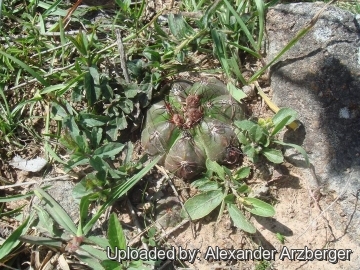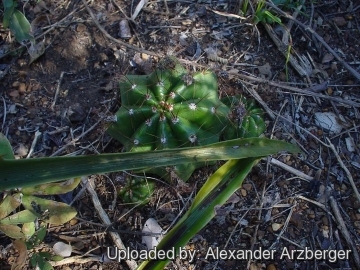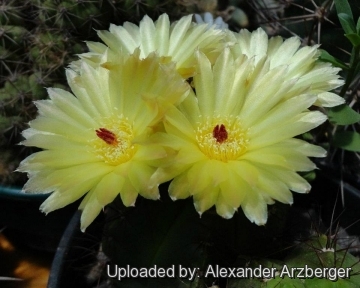Accepted Scientific Name: Parodia oxycostata (Buining & Bredero) Hofacker
Cactaceae Consensus Init. 6: 12. 1998

Notocactus oxycostatus var. occidentalis Photo by: Alexander Arzberger
Origin and Habitat: Notocactus oxycostatusSN|20467]]SN|20467]] var. occidentalis is endemic to Piribebuy and adjacent areas, Cordillera. (Minifundia region), Paraguarí and Missiones, in Central Paraguay (700-800 km west of the State of Rio Grande du Sul, which is the main area of distribution of Notocactus oxycostatusSN|20467]]SN|20467]]).
Synonyms:
See all synonyms of Parodia oxycostata
back
Accepted name in llifle Database:Parodia oxycostata (Buining & Bredero) HofackerCactaceae Consensus Init. 6: 12. 1998Synonymy: 20
Accepted name in llifle Database:Parodia oxycostata subs. gracilis (F.Ritter) HofackerCactaceae (Backeberg) 6: 12. 1998Synonymy: 4
back
Description: Notocactus oxycostatusSN|751]]SN|20467]] var. occidentalis is one of the morphological or geographical form of the widespread and very variable Notocactus oxycostatusSN|20467]]SN|20467]]. It has fattened stems to 60 mm in diameter, clustering with time, and start flowering at an early age, often when only 35 mm in diameter. As with many notocacti, the yellow flowers are produced in profusion from the crown. It is close to Notocactus ottonisSN|20467]]SN|751]].
Derivation of specific name: 'occidentalis' for the occurrence in the far western part of the area of distribution (central Paraguay).
Stem: Flattened spherical, 20-50 mm tall and 30-60 mm (sometimes up to 70 mm) in diameter, dark blue-green to olive green, sometimes violet brown in the sun.
Ribs: Mostly 7, vertical, to 30 mm wide and 15 mm tall almost triangular in cross-section. The sharp rib edges are broken into humps and valleys (up to 2 mm deep).
Areoles: Roundish, small, white woolly, slightly recessed and 8 -12 mm apart mostly 2 mm high and 5 mm wide.
Radial spines: 5, rarely 7, spreading, curved, 5-20 mm long brown, occasionally dark brownish-black and soft or lighter amber-brown.
Central spine: 1 neither stronger nor longer.
Flowers: Several at a time from the apex, lemon-yellow 40-60 mm long and 50-70 mm wide. Buds covered by dark brown wool. Pericarpel green wrapped with brown wool and long stinging bristles. Bracts on the tube 5-10 mm long with brown wool and 2-3 bristles in the axil. Tepals lanceolate, shiny, lemon-yellow, often reddish in the outside, about 6 mm wide and 25-36 mm long. Stamens yellow 9-13 mm long. Style grooved 20-22 mm long and 2 mm thick, the 7-8 purple stigma lobes are 3-4 mm long. The plant is self-fertile.
Fruit: Barrel-shaped, 5 mm wide and 11 mm long, withering when ripe, splitting open along irregular fissures.
Seeds: 0.9 mm wide and 1.1 mm long, cap-shaped. Testa glossy black.
Subspecies, varieties, forms and cultivars of plants belonging to the Parodia oxycostata group
 Notocactus glaucinus F.Ritter: has a waxy bluish coating on the epidermis. Distribution: Rio Grande do Sul, Brazil.
Notocactus glaucinus F.Ritter: has a waxy bluish coating on the epidermis. Distribution: Rio Grande do Sul, Brazil. Notocactus glaucinus var. depressus F.Ritter: has flat light green stem and pink fruits. Distribution: Sao Francisco de Assis, Rio Grande do Sul, Brazil.
Notocactus glaucinus var. depressus F.Ritter: has flat light green stem and pink fruits. Distribution: Sao Francisco de Assis, Rio Grande do Sul, Brazil. Notocactus oxycostatus var. occidentalis N.Gerloff: has flattened spherical stems, 20-50 mm tall and 30-60 mm wide with ca. 7 ribs. Radial spines 5-7. Central spine 1. Distribution: Central Paraguay (Cordillera, Paraguarí and Missiones).
Notocactus oxycostatus var. occidentalis N.Gerloff: has flattened spherical stems, 20-50 mm tall and 30-60 mm wide with ca. 7 ribs. Radial spines 5-7. Central spine 1. Distribution: Central Paraguay (Cordillera, Paraguarí and Missiones). Notocactus oxycostatus f. securituberculatus (F.Ritter) N.Gerloff: has sharp bluish ribs that redden if exposed to strong sun light and under stress conditions. Distribution: Quevedos, Rio Grande do Sul, Brazil
Notocactus oxycostatus f. securituberculatus (F.Ritter) N.Gerloff: has sharp bluish ribs that redden if exposed to strong sun light and under stress conditions. Distribution: Quevedos, Rio Grande do Sul, Brazil- Parodia oxycostata (Buining & Bredero) Hofacker: has 6-7 ribs and reddish brown spines. Distribution: east of Sao Gabriel, Rio Grande do Sul.
- Parodia oxycostata subs. gracilis (F.Ritter) Hofacker: has 9-12 ribs and bright yellow spines. Distribution: near Santiago.
Bibliography: Major references and further lectures
1) Gerloff, N. “Notocactus oxycostatus var. occidentalis N. Gerloff 2003” in Internoto 24(3-4): 76 (75-80; figs.). 2003
 Notocactus oxycostatus var. occidentalis Photo by: Alexander Arzberger
Notocactus oxycostatus var. occidentalis Photo by: Alexander Arzberger Notocactus oxycostatus var. occidentalis, AA 280, S Capilla Tuya, Dep. Paraguari, Paraguay, 203 m. Photo by: Alexander Arzberger
Notocactus oxycostatus var. occidentalis, AA 280, S Capilla Tuya, Dep. Paraguari, Paraguay, 203 m. Photo by: Alexander Arzberger AA 147, Itacurubí de la Cordillera, Paraguay. Photo by: Alexander Arzberger
AA 147, Itacurubí de la Cordillera, Paraguay. Photo by: Alexander Arzberger Notocactus oxycostatus var. occidentalis Photo by: Alexander Arzberger
Notocactus oxycostatus var. occidentalis Photo by: Alexander ArzbergerCultivation and Propagation: They like a warm bright location, does great in partial shade avoid full sun. During winter's rest period they should be dry and cool. It is best to avoid any frost but during the winter the temperature can be as low as 2° C without any harm so long as the compost is very dry, they like only a short winter's rest. If the soil is allowed to be dry for too long root loss could follow but equally the same result would occur if the plants are both wet and cold. Cold spots can mar its epidermis in cold damp conditions. They need good drainage and prefer a neutral to slightly acidic compost with plenty of extra grit. Water and feed during the summer. Best if watered with rain water and given an occasional tonic of sequestrated iron.
Propagation: Usually by seeds, or (rarely) by offsets.















